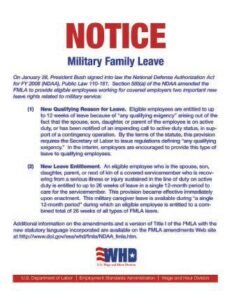
The Family and Medical Leave Act (“FMLA”) was recently amended by the National Defense Authorization Act (“NDAA”) to provide expanded leave opportunities to families of service members serving in Iraq and Afghanistan and injured in those theatres of operation.
In general, under the FMLA, employers with 50 or more employees within a 75-mile radius are required to allow workers to take up to 12 weeks of unpaid leave in a 12-month period because of their own serious health condition, to care for their child after birth or adoption, or because of a serious health condition of their spouse, parent or child. The NDAA amendments add two new types of leave. The first allows an employee who is the spouse, child, parent, or “next-of kin” (the closest blood relative) of a service member up to 26 weeks of leave to care for him if the service member is injured while on active duty. The second permits an employee whose spouse, son, daughter, or parent is on active duty to take up to 12 of weeks leave for any “qualifying exigency” caused by the service member’s call to active duty.
 The Department of Labor (“DOL”) has not yet issued regulations on the new military leave provisions, and while the first type of leave is now effective, the “exigency” leave does not become law until guidance is published. However, the DOL is encouraging employers to offer employees the opportunity to take leave where the circumstances appear to fit within the spirit of the Act.
The Department of Labor (“DOL”) has not yet issued regulations on the new military leave provisions, and while the first type of leave is now effective, the “exigency” leave does not become law until guidance is published. However, the DOL is encouraging employers to offer employees the opportunity to take leave where the circumstances appear to fit within the spirit of the Act.
The NDAA defines “covered service member” as “a member of the Armed Forces, including a member of the National Guard or Reserves, who is undergoing medical treatment, recuperation, or therapy, is otherwise in outpatient status, or is otherwise on the temporary disability retired list, for a serious injury or illness.” The DOL is considering whether there should be some requirement of proximity in time between the injury and treatment, or if an employer should ask for a determination by the Department of Defense.
Many other questions remain unanswered, not the least of which is how an employer can determine if the “qualifying exigency” has arisen as a result of active duty status. The DOL contemplates that this provision would apply to non-medical issues, such as making child care arrangements and addressing financial and legal matters to cover periods of absence.
Employers are required to post a new notice of the military leave provisions adjacent to their current FMLA notice. The notice is available on the DOL website.
The new military leave provisions will add to employers’ burdens in understanding and complying with the requirements of the FMLA. In 2006, the DOL requested comments from employers, to be used in formulating new regulations under FMLA. There was a general expectation that the DOL would clarify and revise existing regulations in a manner that would help employers better balance their own needs with those of their workers and help eliminate abusive situations. In particular, employers were hoping the DOL would address the definition of “serious health condition” and what to do about unscheduled intermittent leave, a growing problem in the workplace.
The Department of Labor issued the new regulations in February, but they contained only minor changes and left unanswered many of the knotty questions posed by employers. The DOL declined to increase the minimum increment of intermittent leave (it can now be as short as an hour) or to permit employers to transfer or otherwise alter the duties of workers who request intermittent leave. The only concession to employers dealing with this difficult situation is the addition of a requirement that the employee make a “reasonable effort” to minimize disruption to the employer’s operations in scheduling intermittent leave.
The most significant changes in the proposed regulations pertain to the notice requirements. For employers, the DOL developed a general notice of FMLA rights, an eligibility notice to be sent to the employee within five business days of receiving a request for leave, and a “designation notice” to be sent to the employee within five days after sufficient information has been received to determine that the leave qualifies under FMLA. The regulations also clarify that an employer can designate leave as falling under FMLA retroactively to the date when leave began.
 The new regulations do contain a few helpful provisions. Employees requesting leave are now required to give reasons for their incapacity to work and information about the anticipated duration and proposed course of action with respect to medical care; calling in “sick” will no longer be sufficient. Also, employers may now call medical providers directly to authenticate medical certifications or to obtain ambiguous or missing information. And employers can now require health care providers to certify employees’ ability to perform specific job functions before they can return to work.
The new regulations do contain a few helpful provisions. Employees requesting leave are now required to give reasons for their incapacity to work and information about the anticipated duration and proposed course of action with respect to medical care; calling in “sick” will no longer be sufficient. Also, employers may now call medical providers directly to authenticate medical certifications or to obtain ambiguous or missing information. And employers can now require health care providers to certify employees’ ability to perform specific job functions before they can return to work.
Compliance with the Family and Medical Leave Act continues to challenge employers, especially in situations where other statutes such as Workers’ Compensation and the Americans with Disabilities Act are involved and the rules are even more difficult to discern. The DOL is being pressed to address these problems when it issues upcoming regulations concerning NDAA leave, but if the February revisions are any indicator, employers are going to continue to go it alone as they travel this rocky path.
FMLA is one of the areas in which Claudia Allen practices extensively. She has been with Strauss & Troy for over 20 years, working in the areas of employment law and employee benefits. She would be happy to answer your questions at 513-629-9462.

